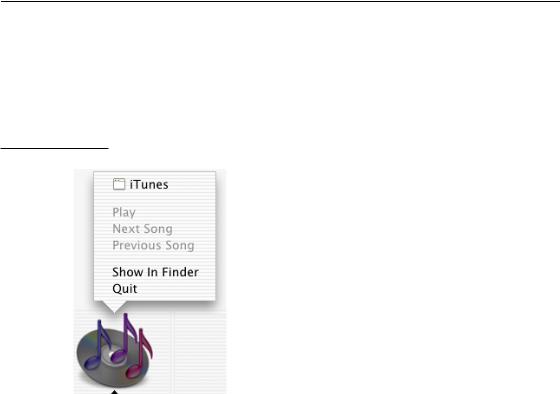
- •Contents
- •Figures and Tables
- •Introduction to the Aqua Human Interface Guidelines
- •The Benefits of Applying the Interface Guidelines
- •Deciding What to Do First
- •Tools and Resources for Applying the Guidelines
- •If You Have a Need Not Covered by the Guidelines
- •Human Interface Design
- •Human Interface Design Principles
- •Metaphors
- •See-and-Point
- •Direct Manipulation
- •User Control
- •Feedback and Communication
- •Consistency
- •WYSIWYG (What You See Is What You Get)
- •Forgiveness
- •Perceived Stability
- •Aesthetic Integrity
- •Modelessness
- •Knowledge of Your Audience
- •Worldwide Compatibility
- •Cultural Values
- •Language Differences
- •Default Alignment of Interface Elements
- •Resources
- •Universal Accessibility
- •Visual Disabilities
- •Hearing Disabilities
- •Physical Disabilities
- •The Dock
- •The Dock’s Onscreen Position
- •Dock Notification Behavior
- •Dock Menus
- •Clicking in the Dock
- •Menus
- •Menu Elements
- •Menu Titles
- •Menu Items
- •Grouping Items in Menus
- •Hierarchical Menus (Submenus)
- •Menu Behavior
- •Scrolling Menus
- •Toggled Menu Items
- •Sticky Menus
- •Standard Pull-Down Menus (The Menu Bar)
- •The Apple Menu
- •The Application Menu
- •The Application Menu Title
- •The Application Menu Contents
- •The File Menu
- •The Edit Menu
- •The View Menu
- •The Window Menu
- •The Help Menu
- •Menu Bar Status Items
- •Other Menus
- •Contextual Menus
- •Using Special Characters and Text Styles in Menus
- •Using Symbols in Menus
- •Using Text Styles and Fonts in Menus
- •Using Ellipses in Menus and Buttons
- •Windows
- •Window Layering
- •Window Appearance and Behavior
- •Textured Windows
- •Opening and Naming Windows
- •Positioning Windows
- •Closing Windows
- •Moving Windows
- •Resizing and Zooming Windows
- •Active and Inactive Windows
- •Click-Through
- •Scroll Bars and Scrolling Windows
- •Automatic Scrolling
- •Minimizing and Expanding Windows
- •Windows With Changeable Panes
- •Special Windows
- •Drawers
- •When to Use Drawers
- •Drawer Behavior
- •Utility Windows
- •The About Window
- •Dialogs
- •Types of Dialogs and When to Use Them
- •Document-Modal Dialogs (Sheets)
- •Sheet Behavior
- •When to Use Sheets
- •When Not to Use Sheets
- •Alerts
- •Dialog Behavior
- •Accepting Changes
- •The Open Dialog
- •Saving, Closing, and Quitting Behavior
- •Save Dialogs
- •Closing a Document With Unsaved Changes
- •Saving Documents During a Quit Operation
- •Saving a Document With the Same Name as an Existing Document
- •The Choose Dialog
- •The Printing Dialogs
- •Controls
- •Control Behavior and Appearance
- •Push Buttons
- •Push Button Specifications
- •Radio Buttons and Checkboxes
- •Radio Button and Checkbox Specifications
- •Selections Containing More Than One Checkbox State
- •Pop-Up Menus
- •Pop-Up Menu Specifications
- •Command Pop-Down Menus
- •Command Pop-Down Menu Specifications
- •Combination Boxes
- •Combo Box Specifications
- •The Text Entry Field
- •The Scrolling List
- •Placards
- •Bevel Buttons
- •Bevel Button Specifications
- •Toolbars
- •Pop-Up Icon Buttons and Pop-Up Bevel Buttons
- •Slider Controls
- •Slider Control Specifications
- •Tab Controls
- •Tab Control Specifications
- •Progress Indicators
- •Text Fields and Scrolling Lists
- •Tools for Creating Lists
- •Text Input Field Specifications
- •Scrolling List Specifications
- •Image Wells
- •Disclosure Triangles
- •Layout Guidelines
- •Group Boxes
- •Sample Dialog Layouts
- •Using Small Versions of Controls
- •User Input
- •The Mouse and Other Pointing Devices
- •Using the Mouse
- •Clicking
- •Double-Clicking
- •Pressing
- •Dragging
- •The Keyboard
- •The Functions of Specific Keys
- •Character Keys
- •Modifier Keys
- •Arrow Keys
- •Function Keys
- •Key Combinations Reserved by the System
- •Recommended Keyboard Equivalents
- •Creating Your Own Keyboard Equivalents
- •Keyboard Focus and Navigation
- •Full Keyboard Access Mode
- •Type-Ahead and Auto-Repeat
- •Selecting
- •Selection Methods
- •Selection by Clicking
- •Selection by Dragging
- •Changing a Selection With Shift-Click
- •Changing a Selection With Command-Click
- •Selections in Text
- •Selecting With the Mouse
- •What Constitutes a Word
- •Selecting Text With the Arrow Keys
- •Selections in Graphics
- •Selections in Arrays and Tables
- •Editing Text
- •Inserting Text
- •Deleting Text
- •Replacing a Selection
- •Intelligent Cut and Paste
- •Editing Text Fields
- •Entering Passwords
- •Fonts
- •Icons
- •Icon Genres and Families
- •Application Icons
- •User Application Icons
- •Viewer, Player, and Accessory Icons
- •Utility Icons
- •Non-Application Icons
- •Document Icons
- •Icons for Preferences and Plug-ins
- •Icons for Hardware and Removable Media
- •Toolbar Icons
- •Icon Perspectives and Materials
- •Conveying an Emotional Quality in Icons
- •Suggested Process for Creating Aqua Icons
- •Tips for Designing Aqua Icons
- •Drag and Drop
- •Drag and Drop Design Overview
- •Drag and Drop Semantics
- •Move Versus Copy
- •When to Check the Option Key State
- •Selection Feedback
- •Single-Gesture Selection and Dragging
- •Background Selections
- •Drag Feedback
- •Destination Feedback
- •Windows
- •Text
- •Multiple Dragged Items
- •Automatic Scrolling
- •Using the Trash as a Destination
- •Drop Feedback
- •Finder Icons
- •Graphics
- •Text
- •Transferring a Selection
- •Feedback for an Invalid Drop
- •Clippings
- •Language
- •Style
- •Terminology
- •Developer Terms and User Terms
- •Labels for Interface Elements
- •Capitalization of Interface Elements
- •Using Contractions in the Interface
- •Writing Good Alert Messages
- •User Help and Assistants
- •Apple’s Philosophy of Help
- •Help Viewer
- •Providing Access to Help
- •Help Tags
- •Help Tag Guidelines
- •Setup Assistants
- •Files
- •Installing Files
- •Where to Put Files
- •Handling Plug-ins
- •Naming Files and Showing Filename Extensions
- •Displaying Pathnames
- •Speech Recognition and Synthesis
- •Speech Recognition
- •Speakable Items
- •The Speech Recognition Interface
- •Speech-Recognition Errors
- •Guidelines for Implementing Speech Recognition
- •Speech Synthesis
- •Guidelines for Implementing Speech Synthesis
- •Spoken Dialogues and Delegation
- •General Considerations
- •Installation and File Location
- •Graphic Design
- •Menus
- •Pop-Up Menus
- •Windows
- •Utility Windows
- •Scrolling
- •Dialogs
- •Feedback and Alerts
- •The Mouse
- •Keyboard Equivalents
- •Text
- •Icons
- •User Documentation
- •Help Tags
- •Document Revision History
- •Glossary
- •Index

C H A P T E R 3
The Dock
Designed to help combat onscreen clutter and aid in organizing work, the always-available Dock displays an icon for each open application and minimized document. It also contains icons for several common user applications, such as Mail and System Preferences, and for the Trash. The Dock provides an Aqua-compatible replacement for the Mac O 9 application menu.
Each item in the Dock has its own rectangular area called a tile. Within each tile is an icon that represents the application, document, folder, or other item in the Dock. For most purposes, you can think of the tile and icon as synonymous, even though the icon does not completely fill the tile.
When a user opens an application, its icon appears in the Dock; when a user opens a document and clicks its minimize button, the document’s icon appears in the Dock. Users can permanently add icons to the Dock and can customize where and when the Dock appears.
For more information, Carbon developers should see Dock Manager Reference, available on the Mac OS X developer documentation website.
The Dock’s Onscreen Position
When opening new windows or resizing windows, position them so that they don’t overlap with the user’s current position of the Dock. Restrict users from resizing a window so that the resize control is behind the Dock.
The Dock’s Onscreen Position |
41 |
Apple Computer, Inc. June 2002 |
|

C H A P T E R 3
The Dock
If the user changes the Dock’s size or position, don’t move or resize application windows that are already open. Users should be able to change specific aspects of their environment without causing other unrequested changes.
Carbon developers can determine the Dock’s size and location using the
GetAvailableWindowPositioningBounds function, which returns a rectangle representing the available Desktop area, not including the menu bar and the space occupied by the Dock. Cocoa developers can use the frame and visibleFrame methods of the NSScreen class.
Dock Notification Behavior
With Mac OS X 10.1 and later, an open application can use its Dock tile to convey important information if needed.
When appropriate, your application’s Dock tile icon can include a small badge superimposed on the icon. In Mail, for example, when a user has unread email, the Dock icon displays a red circle indicating the number of new messages. This type of badging provides important information without being obtrusive or distracting.
Figure 3-1 An example of a badged Dock icon: The Mail application icon indicates there are unread messages
If an open and inactive application needs the user’s attention right away and calls the Notification Manager, the application icon in the Dock bounces. This type of notification should be reserved for errors or problems that the user needs to address right away. If you implement this kind of notification, you should also provide a way for the user to turn off the animation.
42Dock Notification Behavior
Apple Computer, Inc. June 2002

C H A P T E R 3
The Dock
To animate an application or document Dock tile in a Carbon application, look for functions in MacWindows.h that include DockTile. In Cocoa, use the setApplicationIcon: method of the NSApplication class or the setMiniWindowImage: method of the NSWindow class.
Dock Menus
When a user presses and holds the mouse button on your application’s tile in the Dock, a menu appears. The menu lists the application’s open windows and contains the Show In Finder and Quit commands. If the tile has not been permanently added to the Dock, the command Keep In Dock also appears.
Figure 3-2 The iTunes Dock menu
Starting with Mac OS X 10.1, an open application can customize its Dock menu by adding to the default items provided by the Dock. Potential additional items include common commands to initiate actions in your application when it is not frontmost and commands that are applicable when there is no open document window. For example, a mail application could provide commands to initiate a new
Dock Menus |
43 |
Apple Computer, Inc. June 2002

C H A P T E R 3
The Dock
message or to check for new messages. Any command you add to the Dock menu should also be available in your application’s pull-down menus. Application-specific items appear above the standard Dock menu items.
For information on implementing Dock menus, see Inside Carbon: Customizing Your Application Dock Tile, available at the Mac OS X developer documentation website.
Clicking in the Dock
Clicking an application icon in the Dock should always result in a window—a document or another appropriate window—becoming active. In a document-based application that is not open when the user clicks the Dock icon, the application should open a new, untitled window.
While an application is open, the Dock icon has a symbol below it. When a user clicks an open application’s icon in the Dock, the application becomes active and all open unminimized windows are brought to the front; minimized document windows remain in the Dock. If there are no unminimized windows when the user clicks the Dock icon, the last minimized window should be expanded and made active. If no documents are open, the application should open a new window. (If your application is not document based, display the application’s main window.)
When the user quits the application, the icon no longer appears in the Dock (unless the user has chosen to always display it in the Dock). Users can add an application icon permanently to the Dock by choosing Keep In Dock from the Dock menu while the application is open or by dragging the item from the Finder to the Dock.
44Clicking in the Dock
Apple Computer, Inc. June 2002
